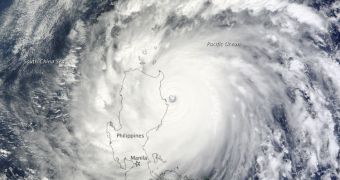Yesterday, October 18, the most intense tropical storm of the season struck in the western Pacific Ocean, making landfall in the northeastern parts of the Philippines, in the Isabela Province.
According to meteorologists, this was the 7th cyclone of the 2010 season, and also the most intense. It was also the 15th tropical storm recorded in these parts of the world.
The atmospheric event was impressive as viewed from a satellite, featuring a diameter of no less than 370 miles, or about 600 kilometers.
The latest data seem to indicate that the tropical storm had turned into a “super typhoon””with category 5 strength on the Saffir Simpson scale, and that oit was bearing down on Palanan Bay.
These reading were collected at 10:35 am Philippine Time (02:35 UTC) on October 18, by the Moderate Resolution Imaging Spectroradiometer (MODIS) instrument on the NASA Terra satellite.
Local reports from the affected areas show that Megi triggered sustained winds of up to 268 kilometers (167 miles) per hour, at around 8 am local time yesterday. The announcement was made by the Joint Typhoon Warning Center.
The Philippine Atmospheric, Geophysical and Astronomical Services Administration, which has its own naming system, calls this storm Juan, even if Megi is the international name.
At this point, experts believe that there is life in the atmospheric even still. After passing through the Philippines, the storm is expected to move into the South China Sea, where it will again intensify.
Later this week, it will probably make landfall in either China or Vietnam. Aware of this, the Beijing authorities have called upon local governments to make the necessary emergency preparations.
According to Our Amazing Planet, Megi was classified with the “super” typhoon status on October 16, and the storm produced winds of up to 178 miles (287 kilometers) per hour before making landfall.
The typhoon only made a single victim thus far, but left an unspecified number of people injured. It has however created significant property damage, and will most likely continue to do so throughout the week.
One of the things that worry authorities is that rice crops may have been severely affected. In most parts of Asia, this is a staple food for many people, and no country can afford to lose its rice.

 14 DAY TRIAL //
14 DAY TRIAL //